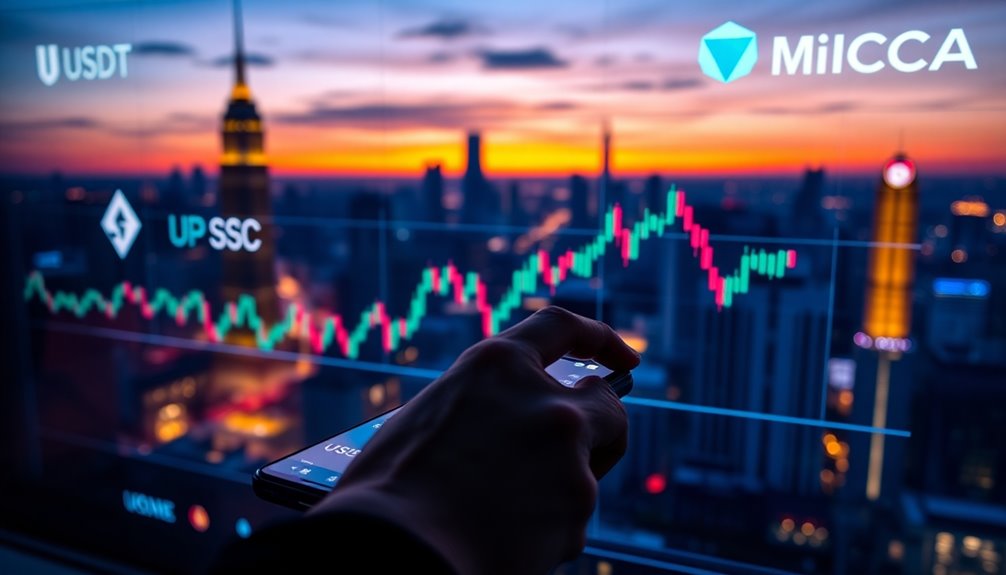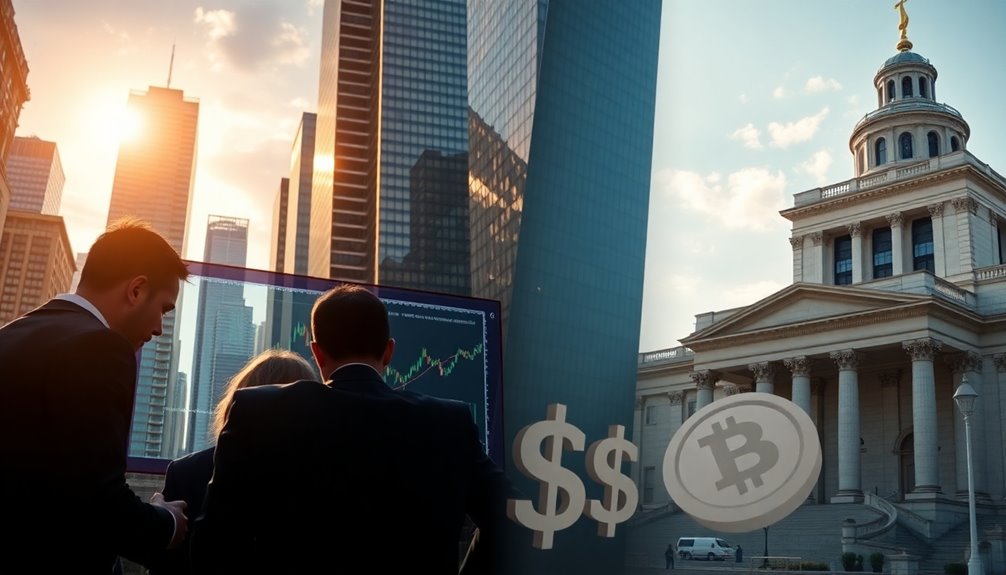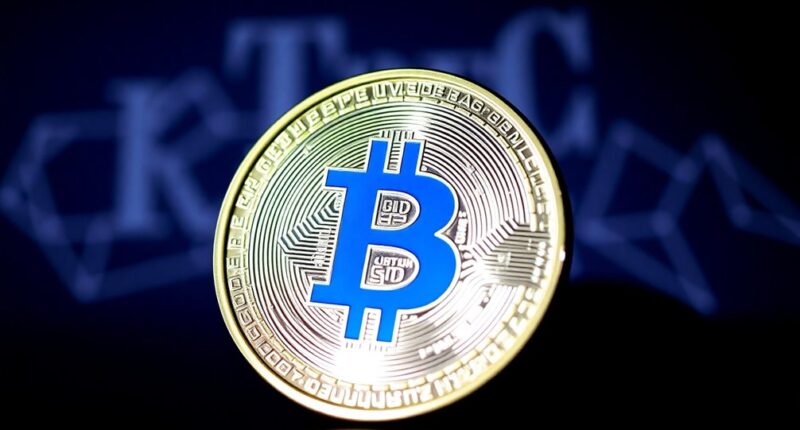Yes, USDT is losing its edge as USDC benefits from regulatory changes like MiCA. With USDT facing delistings due to compliance issues, traders are shifting their trust to USDC, which boasts a growing market cap and strict audits. The USDC's compliance attracts more institutional interest, while USDT's market dominance declines. As USDC's adoption spikes, supported by a 78% increase in circulation, this challenges USDT's long-standing position. The evolving landscape suggests that trends favor compliant stablecoins. Stick around to uncover more about how these shifts impact the overall crypto market and your investment strategies.
Key Takeaways
- USDT faces declining confidence due to regulatory challenges, with $4 billion redeemed before MiCA enforcement, leading to potential market dominance loss.
- MiCA regulations impose a 60% reserve requirement, prompting USDC's compliance, enhancing its appeal among traders and institutions.
- USDC's market capitalization has surpassed $45 billion, growing by 78% year-over-year, indicating increasing trust and adoption in the market.
- The rise of new competitors prioritizing regulatory compliance and transparency threatens USDT's position, as USDC attracts fintech startups and exchanges.
- Innovations in yield-bearing solutions and corporate blockchain adoption position USDC as a more attractive option for businesses compared to USDT.
Market Dynamics and Regulatory Shifts

As the regulatory landscape evolves, it's crucial to understand how these changes impact market dynamics, particularly for stablecoins like USDT.
The introduction of MiCA regulations has imposed stringent compliance requirements, including a 60% reserve necessity for issuers within EU banks. This shift has prompted significant reactions; nearly $4 billion in USDT was redeemed just before MiCA took effect, indicating waning confidence.
Tether's hesitance to meet these regulations has resulted in delistings from major exchanges. In contrast, USDC has embraced compliance, gaining traction as a preferred stablecoin among traders. This shift in preference comes as institutional investment in Bitcoin has surged, further solidifying USDC's position in the market.
As USDC's market cap continues to grow, the competitive landscape is shifting, suggesting a potential decline in USDT's dominance. Your investment choices might need reevaluation in this evolving environment.
New USDC Regulations Announced

With the recent announcement of new regulations for USDC, the stablecoin landscape is shifting towards stricter compliance and enhanced transparency.
USDC has become the first major global stablecoin issuer to align with the EU's Markets in Crypto Assets (MiCA) regulation, securing an Electronic Money Institution (EMI) license from France. This compliance means USDC undergoes rigorous audits from firms like Grant Thornton, ensuring it remains fully backed by U.S. dollars and Treasuries. Additionally, these measures align with regulatory compliance best practices in the cryptocurrency sector, further enhancing trust.
Such measures boost USDC's appeal to startups in the EU, minimizing risks linked to non-compliant alternatives.
With a market capitalization exceeding $45 billion and a growing global user base, USDC is setting new standards for safety and reliability in the ever-evolving cryptocurrency market. Additionally, its circulating supply grew by 78% year-over-year, highlighting its increasing adoption and trust among users.
Crypto Volatility and Trading Volume

Crypto markets are notoriously volatile, and this instability significantly impacts trading volume across various stablecoins.
You might notice that Bitcoin's expected fluctuation of about 18.13% over the next month, based on the CAPIVIX Index, drives traders to adjust their strategies frequently. Additionally, the CAPIVIX methodology focuses on forward-looking volatility, providing traders with insights that can help them navigate these price swings. Understanding risk tolerance is crucial for traders as they develop strategies to manage their investments effectively.
As USDT faces regulatory challenges and a capitalization drop, USDC is gaining traction, with a $1.7 billion increase in capitalization recently.
The trading volume reflects this shift, with FDUSD capturing 48% of BTC pairs on Binance, while USDT holds only 42%.
As you navigate this landscape, keep an eye on how these dynamics shape your trading decisions and the overall market environment, especially as compliance issues continue to unfold.
Corporate Blockchain Integrations

The increasing volatility in the crypto market is pushing corporations to explore innovative solutions, and blockchain technology has emerged as a key player. Companies are integrating AI with blockchain to enhance data integrity and operational efficiency, with projections suggesting this market could exceed $703 million by 2025. Moreover, the tokenization of real-world assets is on the rise, expected to reach $600 billion by 2030, enabling banks to issue tokenized assets and democratize capital markets. As interoperability becomes more refined, decentralized finance (DeFi) is set to revolutionize banking, offering compliant and transparent services. With stablecoins like USDC gaining traction, corporations are navigating this evolving landscape to streamline transactions and seize new business opportunities. Additionally, businesses will benefit from enhanced security measures as they integrate blockchain solutions to protect user data. Furthermore, employing AI automation can significantly enhance decision-making processes within these corporate frameworks.
Regulatory Hearings and Decisions

As regulatory bodies around the world tighten their grip on the cryptocurrency market, stablecoin issuers like USDT are facing increasing scrutiny.
The EU's MiCA regulations, effective December 30, 2024, require stablecoin issuers to hold 60% of their reserves in EU banks. This has led to significant redemptions for Tether and prompted exchanges like Coinbase and OKX to delist USDT for European users. Nearly $4 billion USDT redeemed before MiCA enforcement showcases the immediate impact of these regulations.
Meanwhile, USDC has secured MiCA approval, positioning itself favorably.
In the U.S., anticipated stablecoin legislation could double the total supply to over $400 billion by 2025.
With rising regulatory clarity and complex compliance requirements, the landscape is shifting toward more transparent stablecoins, putting USDT's dominance at risk.
Emerging Stablecoin Competitors

With increasing scrutiny on stablecoins like USDT, new competitors are emerging that prioritize regulatory compliance and transparency.
USDC stands out as a compliant alternative, having secured approval under the EU's MiCA regulations. This compliance attracts fintech startups and exchanges eager to align with EU rules. Additionally, the stablecoin market is projected to grow significantly in 2025, with increased use cases in payments and remittances. With a market cap growth of $2 billion since its MiCA license, USDC is poised to capitalize on the stablecoin market, projected to double by 2025.
Its transparent reserve holdings and regular audits foster trust, contrasting sharply with USDT's lack of full-scale audits.
Moreover, yield-bearing solutions offered by USDC are drawing users, further shifting the landscape in its favor as compliance becomes paramount in the evolving crypto market.
Frequently Asked Questions
What Are the Benefits of Using USDC Over USDT?
When you consider using USDC over USDT, you'll find several benefits.
USDC offers greater transparency with regular audits and a clear reserve structure, enhancing trust. Its simpler redemption process makes access easy, with lower minimum requirements and no verification fees.
Additionally, USDC's compliance with regulations like MiCA ensures it faces fewer challenges, boosting its reputation.
All these factors contribute to USDC being a more secure and reliable choice for your transactions.
How Does Mica Affect Individual Crypto Investors?
MiCA significantly impacts you as an individual crypto investor by enhancing protection and transparency.
With clear regulations, you can trust that crypto service providers must comply with strict licensing and anti-money laundering rules. This boosts your confidence, knowing there are safeguards against fraud and market manipulation.
Improved consumer rights and transparency reports mean you'll have access to reliable information, making it easier to navigate the crypto landscape and make informed decisions.
What Is the Future of Stablecoins Beyond USDT and USDC?
As the landscape of stablecoins evolves, you'll find a vibrant tapestry of opportunities beyond USDT and USDC.
Emerging players like FDUSD and RLUSD are stepping into the spotlight, offering enticing alternatives with regulatory compliance and innovative features.
You'll see a shift towards yield-bearing options, attracting users eager for returns.
With advancements in technology and changing market dynamics, the future of stablecoins promises to be both exciting and rewarding for savvy investors like you.
How Do Regulatory Changes Influence Crypto Adoption Rates?
Regulatory changes significantly influence your crypto adoption rates. When regulations provide clarity and legitimacy, you're more likely to invest.
Compliance-driven frameworks attract traditional investors, boosting market confidence. Stricter rules, like those from MiCA, can reshape liquidity by affecting stablecoin issuers.
As you see increased enforcement and clearer guidelines, you may feel more secure entering the crypto space, leading to higher adoption rates and a more robust market overall.
Are There Risks Associated With Using Stablecoins in General?
Yes, there are several risks associated with using stablecoins.
You might face market and liquidity risks during sudden redemption spikes, potentially leading to fire sales.
Operational risks like fraud and cyber threats arise, especially with unregulated issuers.
Additionally, using stablecoins can expose banks and financial institutions to significant losses and reputational damage.
Conclusion
As you watch the crypto landscape shift, the question looms: is USDT still the heavyweight champion, or are emerging players like USDC and MICA ready to dethrone it? The air is thick with uncertainty, and every regulatory decision could tip the scales. Picture the digital arena, where volatility reigns and new contenders rise. Keep your eyes peeled—this isn't just a market; it's a battleground, and the next move could redefine everything you thought you knew.









